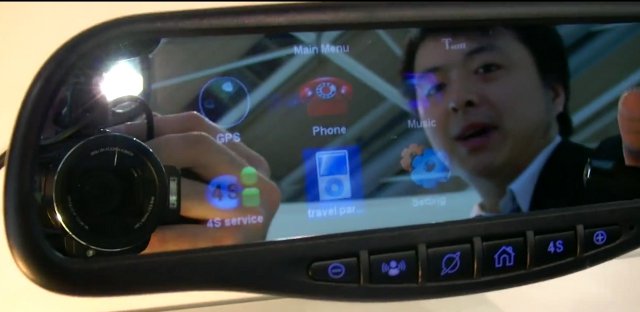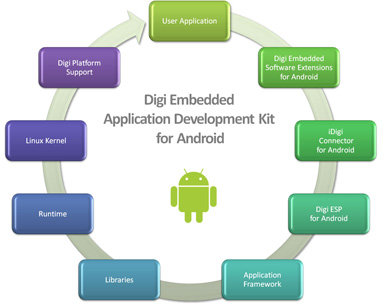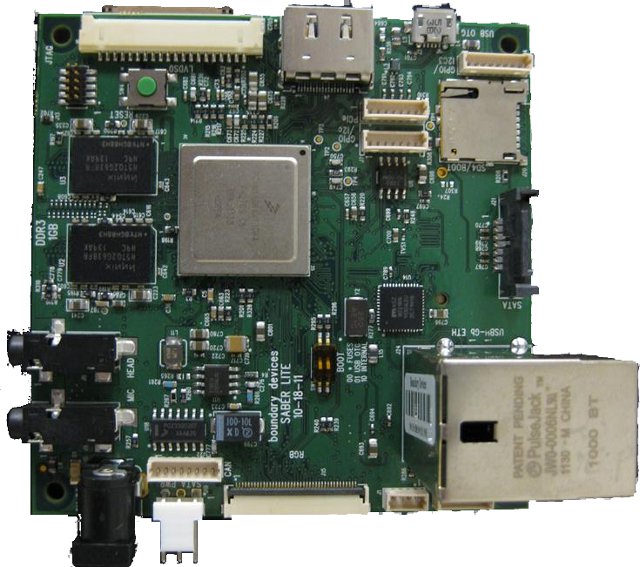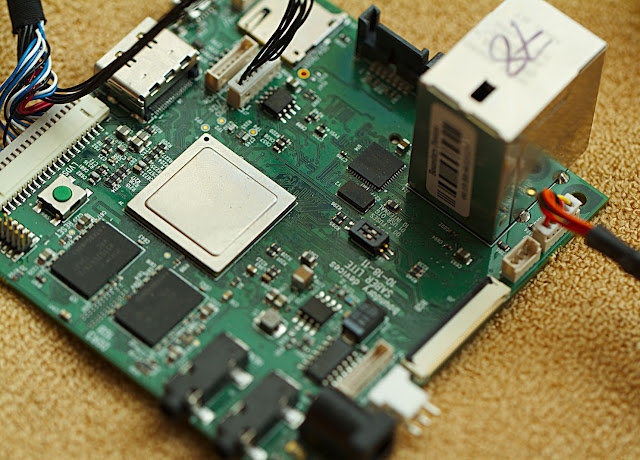Huawei is exhibiting their Machine to Machine (M2M) solutions at Cebit 2012 until March 10, 2012. They are showcasing Smart Meter solutions with home energy gateways, smart gas meters, smart electric meters, in-home displays.. all communicating via Zigbee. Their solution is currently being implement in the UK market. They are also exhibiting diverse modules (mainly based on Freescale i.MX5 processor) featuring Huawei 3G technology that could be used in tablets among other things. But the thing is really found interesting was their M2M solutions for the auto industry especially the Android car rear-view mirror where you can have the left half of the rear-view mirror displaying a menu so that you can access apps such as GPS maps, control your music or your phone and see information about your car. Here are some details above this rear-view mirror: Samsung SP5V210 Cortex A8 Processor 4.3″ TFT capacitive touchscreen – Resolution: 800×480 […]
Digi International Unveils Embedded Application Development Kit for Android
Digi International has released its Application Development Kit for Android (the world first Android embedded application devkit according to the company) at Embedded World 2012. This Development Kit is comprised of both software and hardware components. The software development kit (SDK) includes drivers and Digi software extensions to create Android-based applications on embedded platforms while eliminating tedious driver development work. The kit also includes one of 2 Digi Wireless modules based Freescale i.MX51 (ConnectCore Wi-i.MX51) and i.MX53 (ConnectCore for Wi-i.MX53). The complete Digi Android development kit includes: Quick start guide Digi Application Development Kit for Android CD/DVD Documentation and development board schematics ConnectCore Wi-i.MX53 module – 1 GHz Freescale i.MX53, 512 MB NAND Flash, 512 MB DDR2, -20 to +70° C. 7″ WVGA LCD panel with touchscreen Digi JumpStart Kit development board: 3 serial ports (1 x RS-232/422/485, 1 x RS-232 Tx/Rx, 1 x TTL) VGA and HDMI 1.3 video outputs […]
Boundary Devices Unveils Nitrogen6X Freescale i.MX6 Development Kit (aka i.MX6q Sabre Lite)
Arrow Electronics and Boundary Devices have launched the Nitrogen6X, a low cost development kit based on Freescale i.MX6 quad-core cortex A9 processor. Here are the technical specifications of the Nitrogen6X board: Quad-Core ARM Cortex A9 processor at 1GHz (i.mx6Quad) 1 GB of 64-bit wide DDR3 @ 532MHz Board Dimensions: 4.5″ x 3″ 2MB Serial Flash Three display ports (PRGB, LVDS, HDMI) Parallel camera port with OV5642 Interface Multi-stream-capable HD video engine delivering 1080p60 decode, 1080p30 encode and 3-D video playback in HD Superior 3-D graphics performance with quad shaders for up to 200 Mt/s Separate 2-D and/or Vertex acceleration engines for an optimal user interface experience Serial ATA (SATA) Dual SDHC card slots PCI express port Analog (headphone/mic) Audio 10/100/1G Ethernet with Power over Ethernet support 2 RS-232 Serial ports 10-pin JTAG interface I2C/GPIO/SPI 3 High speed USB ports (2xHost, 1xOTG) CAN port TiWi 802.11 b/g/n WiFi+BT optional Supports Android […]
Ubuntu on ARM: Improvements and Optimizations Done by Linaro – ELCE 2012
Ricardo Salveti de Araujo, developer platform lead for Linaro, displays the improvements Linaro have added to Ubuntu on ARM. Abstract: Since Linaro’s start, there was a need to have a supported platform for ARM, that could use the Linaro changes, to improve the ARM experience in general and to show the results of the work done by Linaro. In this session, it’ll be presented why Ubuntu was selected as the base platform for Linaro, describing the benefits and the areas Linaro is continuously investing to improve it. It’ll also be described the current state of the platform, showing some of Linaro’s achievements and also how we’re working to support the main SoC boards available, like Panda, Beagle, Origen, iMX53 and Snowball with the latest development by Ubuntu and Canonical, like Ubuntu TV, Phone and Tablet. You can also download the presentation slides. Jean-Luc Aufranc (CNXSoft)Jean-Luc started CNX Software in 2010 […]
The Yocto Project Overview and Update – ELC 2012
Saul Wold, User Space Architect at Intel Open Source Technology Center, discusses the latest on the Yocto Project at the Embedded Linux Conference 2012. Abstract: The Yocto Project is a joint project to unify the world’s efforts around embedded Linux and to make Linux the best choice for embedded designs. The Yocto Project is an open source starting point for embedded Linux development which contains tools, templates, methods and actual working code to get started with an embedded device project. In addition, the Yocto Project includes Eclipse plug-ins to assist the developer. This talk gives a walk-through of the key parts of the Yocto Project for developing embedded Linux projects. In addition, features will be described from the latest release of Yocto. At the end of the talk, developers should be able to start their own embedded project using the Yocto Project and use it for developing the next great […]
Low Cost Freescale iMX6 Quad Sabre Lite Development Board
i.MX6q SABRE Lite Board is a low-cost development platform based on Freescale Quad Core Cortex A9 i.MX 6Quad Application Processor. This will probably be the first low cost ARM quad-core development board to hit the market. Nvidia has previously announced the CARMA Tegra 3 CUDA Development Kit, but the price has not been announced and when I look at the picture of the board and the specs, “low cost” does not come to mind. Here are the technical specifications for the Sabre Lite board: Quad-Core ARM® Cortex A9 processor at 1GHz per core 1GB DDR3 @ 532MHz 3 display ports (RGB, LVDS, and HDMI 1.4a) Two camera ports (1xParallel, 1x MIPI CSI-2) Multi-stream-capable HD video engine delivering H.264 1080p60 decode,1080p30 encode and 3-D video playback in HD Triple Play Graphics system consisting of a Quad-shader 3D unit, and a separate 2-D and separate OpenVG Vertex acceleration engine for superior 3D, […]
Linaro 12.02 Release with Kernel 3.3-rc
Linaro has just released version 12.02 based on Linux Kernel 3.3-rc and Android 4.0.3. Among the key points, they have started to work on Freescale i.MX6 SabreLite board, included libav 0.8 to Ubuntu images which provides up to 160% performance improvement while playing real-media videos and XBMC is available via PPA. Here are the highlights of the release: Android Linaro Android can now be built with current GCC 4.7 snapshots. A 4.7 based toolchain build preview is also available. Linaro Android can boot on iMX6 Sabrelite boards. All test result spreadsheets have been streamlined and are now easier to use. Bluetooth enablement have been completed for the Origen board. A Prototype of using camera on Snowball was made. Presentations Given by Linaro Android Team this cycle “Binary Blobs Attack!!!” – Embedded Linux Conference. “What Android and Embedded Linux can learn from each other” – Embedded Linux Conference. “Integrating Projects Using […]
Seneca Uses GuruPlug Server Farm to Build Raspberry Pi Fedora Distribution
Prior to the Raspberry Pi Fedora 14 Remix launch party, Seneca has uploaded a video showing the work they have done to have Fedora 14 work on Raspberry Pi. Here are some interesting points ion this video: All basics application such as a web browser, office suite, the components you need to build a LAMP (Linux, Apache, MySQL, PHP) server… are already working. 2D graphics acceleration is not implemented yet, so the first release may feel a bit sluggish. But eventually, since the Raspberry Pi has a pretty good GPU, 2D support (OpenVG in Cairo library?) will be implemented at some points in time, either by Seneca or other people in the development community. Seneca uses around 60 ARM devices in their build farm that generates all the binaries for the Fedora ARM Remix release (e.g. the ones you can get with “yum install”) and among those device there are […]







